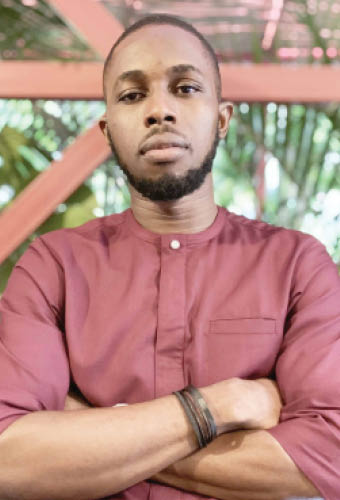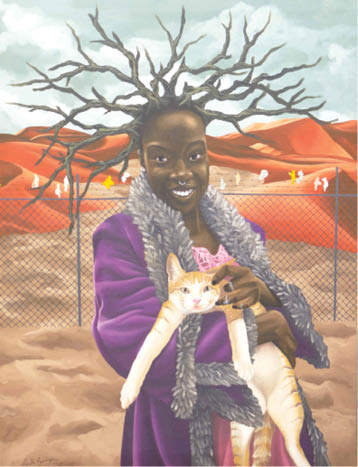‘Mistakes while painting are merely delusional’
Although he harnessed his drawing skills from an early age, Ebuka Pascal Agudiegwu took up painting professionally during the COVID-19 pandemic. In this interview with Daily Trust on Sunday, Agudiegwu shares the intrigues of his artistic creations. What initially drew you to working with acrylics as your primary medium? Unlike other mediums, acrylic is […]

Ebuka Pascal Agudiegwu
Although he harnessed his drawing skills from an early age, Ebuka Pascal Agudiegwu took up painting professionally during the COVID-19 pandemic. In this interview with Daily Trust on Sunday, Agudiegwu shares the intrigues of his artistic creations.
What initially drew you to working with acrylics as your primary medium?
Unlike other mediums, acrylic is very easy to use and manipulate; especially, being a water based medium and also a fast-drying medium. I loved it because at the very early stages of my career, I enjoyed painting miniature works and I could make quiet a number of miniature paintings on chipboard in a day and acrylic is very suitable for that kind of fast paintings.
How would you describe the unique qualities and characteristics of acrylic paint compared to other mediums?
My answer to this question will be rather subjective, as different artists would have other preferences based on their kind of work. Because I enjoy panting very fast and not having to wait for a longer time to work on a painting, the acrylic medium serves me best. Although I use other mediums and mixed media techniques in my works but I work primarily with acrylic.
What is your favourite aspect of working with acrylics?
Aside from the fact that acrylic dries very fast compared to other mediums like oil, it’s also a water-based medium which for me is very perfect. I am not always comfortable working with oil because of the smell of the mixing media.
Are there any specific techniques or approaches you use when working with acrylics that you find particularly effective or enjoyable?
Not necessarily, although I like to do an underpainting layer with wash technique, this make my work faster. But I don’t always start a painting with wash.

How do you handle the fast-drying nature of acrylic paints?
This used to be a challenge, trust me, but I guess I was able to adapt and develop some techniques to manage it. I always have a water spray bottle with me, which I use to keep my paint wet on my pallet. Wetting acrylic lightly makes it easy to paint with especially when you enjoy blending. I also have a specialized kind of pallets which I organize in racks. That way, I can use a mixed acrylic paint for weeks and even months. I’m better adapted to acrylic than oil I guess.
Have you experimented with different textures or additives to create interesting effects with acrylics?
No, not yet, although I intend to do that in the nearest future.
What are some challenges you have encountered while working with acrylics, and how have you overcome them?
My working with acrylic has been great, I won’t say I find it challenging because to me it’s the easier medium, well suited for an artist like me.
Do you have a preferred surface or substrate for painting with acrylics?
I will say canvas. But acrylic can also be used on various conventional and unconventional surfaces with ease. But I enjoy painting with acrylic on canvas.
How do you approach colour mixing and achieving the desired hues and tones with acrylics?
Colour mixing used to be a big deal for me at the early stages of my painting career, but now I’m better adapted to paint mixing. I work basically with warm and cool hues and I mix desired colours into different covered plates mostly secondary and some tertiary colours, which I can tint or shade when necessary.
Can you share any tips or tricks for achieving depth and dimension in your acrylic paintings?
Basically, I use an aerial perspective technique to create depth in most of my paintings as most of my paintings have my subjects situated in the unique environment I created. Other times, I use the shading of my hues to make them look faded and further into the depth of the paintings. I do this a lot when I’m painting rocks or mountains.
Have you ever combined acrylics with other mediums in your artwork? If so, how did that enhance your creative process?
I have some paintings I created with either acrylic and charcoal or acrylic and oil and they are pretty cool. Although, I use oil when I want to create a vintage vibrant effect on some areas of my paintings. Initially, I make mixed media paintings with charcoal and acrylic and it did come out nice too.
What inspires your choice of subject matter when working with acrylics?
I get most of my inspirations from my day-to-day conversations or interactions with friends, and even the kind of music I listen to. I love listening to music, I don’t think I can make art without playing music. Music puts me in a good mood, so I’m able to make meaning off the littlest details.
Have you ever faced any unexpected or surprising results while working with acrylics? How did you adapt to them?
It’s a common aspect of making art, often times I get results that are not what I imagined but I acknowledge the fact that creating art is a way of letting out what transpires in my subconscious mind. There are days I sit in front of my paintings in process or completed just so I can figure it out. Sometimes, it feels like I’m communicating with my inner-self which is visually represented on the canvas. Whichever way a painting turns out, I take it as it is and would figure out why it came out that way. I wouldn’t say it’s complicated entirely but it’s an interesting process that is unique to the artist himself.
What’s the longest time you’ve spent on a painting?
I think two years. I work on so many paintings at a time, ranging from 5-8 paintings at a time. I do this because I don’t want to get bored working on a particular painting and I only work on a painting when I feel like I have something I want to add. So, for this reason, some of my paintings take up to a year to finish while some get finished in a day or two. I’m very fast with painting, the only thing I’m not so quick at when painting is deciding or settling for something or an idea.
How do you know when an artwork is complete?
An art work is never complete unfortunately. You just get tired of it, or your attention shifts to some other painting. Well, that’s for me, because I have some paintings which I painted over another painting and I can afford to do that over and over. It’s fun, it’s what I love most with acrylic paintings.
What do you intend to project into the minds of your audience through you painting?
Well, a lot I must say. Although my works are primarily hinged around relationships and perspectives, and as much as I want to suggest or prick the consciousness of my audience, I like my audience to have minds of their own when they view my works. I believe what we experience helps us to reflect better who we are, and so my works should help my audience reflect on their personality and subjective views.
As an artist, how do you deal with creative blocks?
Oh my God! It’s annoying trust me. I paint every day and when I don’t get to paint because I don’t know what to paint, I feel useless literally. I have been there a couple of times and I know exactly what it feels like for a creative to experience creative blocks. Although I have ways I overcome my creative blocks, I just indulge in other fun activities like seeing movies, visiting galleries, engaging in conversations with other artists in their studio and it just puts me back on track.
Do you have any advice for aspiring artists who are interested in exploring acrylics as a medium for their own creative expression?
The trick for me is as a novice with acrylic, take your mind away from the fear of failing. I tell myself one thing when it feels like the process is becoming too tedious and that is “I am the god and my paintings are my beloved creations”. With this in mind, I already feel powerful and understand that mistakes when painting are merely delusional. You can make meaning with every stroke and can even capitalize on a supposed mistake to further make the work better.
